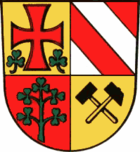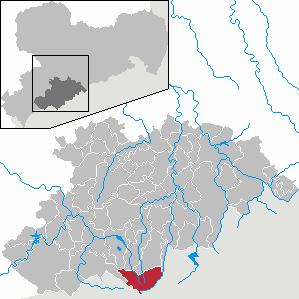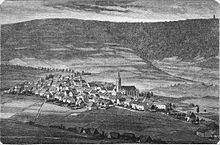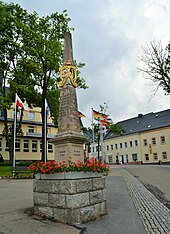Oberwiesenthal
| coat of arms | Germany map | |
|---|---|---|

|
Coordinates: 50 ° 25 ' N , 12 ° 58' E |
|
| Basic data | ||
| State : | Saxony | |
| County : | Erzgebirgskreis | |
| Height : | 914 m above sea level NHN | |
| Area : | 40.02 km 2 | |
| Residents: | 2078 (Dec. 31, 2019) | |
| Population density : | 52 inhabitants per km 2 | |
| Postal code : | 09484 | |
| Area code : | 037348 | |
| License plate : | ERZ, ANA, ASZ, AU, MAB, MEK, STL, SZB, ZP | |
| Community key : | 14 5 21 440 | |
| LOCODE : | DE XYC | |
| City structure: | 5 districts | |
City administration address : |
Markt 8 09484 Oberwiesenthal |
|
| Website : | ||
| Mayor : | Mirko Ernst ( FDP ) | |
| Location of the city of Oberwiesenthal in the Erzgebirge district | ||
Oberwiesenthal (since May 29, 1935 Oberwiesenthal health resort ) at the foot of the Fichtelberg is 915 m above sea level. NHN the highest town in Germany and the winter sports resort in the Ore Mountains with the most overnight stays. The city bears the title of a state-recognized health resort .
geography
Location and mountains
Oberwiesenthal lies on the ridge of the Middle Ore Mountains in the Ore Mountains District , on the border with the Czech Republic , which follows the course of the Pöhlbach to Bärenstein (10 km northeast) .
- The highest elevation of the place is the Fichtelberg at 1215 m above sea level. NN , the highest mountain in Saxony.
Significant mountains in the vicinity of Oberwiesenthal are:
- Keilberg (Klínovec) ( 1244 m nm ; highest mountain in the Ore Mountains)
- Kleiner or Hinterer Fichtelberg ( 1206 m above sea level )
- Eisenberg ( 1029 m above sea level )
Neighboring communities
On the Czech side are the municipalities Loučná pod Klínovcem (Bohemian Wiesenthal) and further west Jáchymov (Sankt Joachimsthal) and Boží Dar (Gottesgab) . Neighboring communities in Germany are Bärenstein , Crottendorf , Sehmatal , Breitenbrunn / Erzgeb. and Raschau-Markersbach .
City structure
- Oberwiesenthal (with the Neues Haus housing estate )
- Unterwiesenthal (with the settlements of Rotes Vorwerk , Weißes Vorwerk, Roter Hammer and Berghäuser ("Am Berg"))
- Hammerunterwiesenthal (with the Bärenlohe settlement)
Oberwiesenthal and Unterwiesenthal merged on September 1, 1921 to form the town of Oberwiesenthal, which has been called Oberwiesenthal health resort since May 29, 1935 . On January 1, 1997 Hammerunterwiesenthal became a district of the town of Kurort Oberwiesenthal.
history
16th to 19th century
Today's Oberwiesenthal district of the Oberwiesenthal health resort was given mountain freedom as Wyssenthal on March 19, 1527 by Duke Georg von Sachsen for a period of six years, after silver ore had been found in the upper mine ground in 1525. The condition was that the extracted silver be delivered to the Annaberger Mint. On March 22, 1527 the Lords of Schönburg granted the miners' settlement additional rights. The granted mountain freedoms were extended by the respective Duke / Elector of Saxony at regular intervals until 1570. On April 18, 1570, the community of Wiesenthal ( poor community of the Pergk Stedlin Neustadt Wiesenthal ) asked Elector August again for mountain freedom and the establishment of a free market. However, the community only received the right to a free market and its own court, and thus city rights, through Duke Christian von Sachsen on July 25, 1588. In addition to the new mining town of Oberwiesenthal , the community in Alten Undern Wiesenthal is also mentioned here. Altwiesenthal , now known as Unterwiesenthal, to the east of Neustadt Wiesenthal , was mentioned in a document as Wizinthal as early as 1406 . Both places were jointly referred to as Deutsch Wiesenthal , in contrast to the Bohemian Wiesenthal on the other side of the Pöhlbach . Around 1650, both places saw an influx of Protestant exiles who had to leave the Kingdom of Bohemia as a result of the Counter-Reformation and found a new home across the border. To the north of Unterwiesenthal, the Hammerunterwiesenthal settlement was established in 1657 by the settlement of exiles.
At that time, Oberwiesenthal and Unterwiesenthal belonged to the upper county of Hartenstein , which had been part of the Schoenburg rule since 1416 and belonged to the Albertine line of the Wettins since the Leipzig division in 1485 . The red and silver shield of the Lords of Schönburg in the coat of arms of Oberwiesenthal comes from this lordship. In 1539/40 the Reformation was introduced in the county of Hartenstein and thus also in the old and new town of Wiesenthal . With the sale of the upper part of the County of Hartenstein to the Wettins, the old and new towns of Wiesenthal were incorporated into the newly founded Electoral Saxon Office of Crottendorf on May 2, 1559 . From the beginning, this was administratively closely related to the neighboring Schwarzenberg district office , with which it was finally united in 1670. In 1832 the Schwarzenberg district office was reorganized. From the south-eastern part of the office around Oberwiesenthal and neighboring places, a judicial and rent office in Oberwiesenthal was formed under the name Office Wiesenthal and Court Wiesenthal.
The first joint church for Oberwiesenthal and Unterwiesenthal was built in the 16th century exactly on the boundary between the two places. The previously existing chapel in Altwiesenthal near the level crossing that was built in the 19th century became superfluous and demolished. Between 1665 and 1669, instead of this half-timbered church, a stone town church was built in the same place. After the destruction by the town fire in 1862, today's Martin Luther Church , which has been known as the Martin Luther Church since 1927 , to which Oberwiesenthal, Tellerhäuser and the branch church in Hammerunterwiesenthal belong.
Mining came to a standstill in the 19th century. After the transition into the 20th century, tourism increasingly took its place. The Cranzahl – Kurort Oberwiesenthal narrow-gauge railway , which opened on July 19, 1897, was also used to develop the Fichtelberg region. In Cranzahl it is connected to the Weipert – Annaberg standard-gauge railway line and is now operated under the name “Fichtelbergbahn”. The number of visitors also increased on the Fichtelberg with the opening of the first Fichtelberghaus in 1888 and the Fichtelberg suspension railway in 1924.
Since 1856, Oberwiesenthal was the seat of the Oberwiesenthal judicial office , whose administrative district was incorporated into the district administration of Annaberg in 1875 .
20th century to the present
As early as 1902, the first unsuccessful talks between the Annaberg administration and the mayors of Oberwiesenthal and Unterwiesenthal about the unification of the two cities took place. On September 1, 1921, after years of negotiations, the voluntary amalgamation of Oberwiesenthal and Unterwiesenthal to form the town of "Oberwiesenthal" was completed. The new municipality received a new coat of arms, which was combined from parts of the two city coats of arms of the current districts. In 1935 the city of Oberwiesenthal was given the name "Kurort Oberwiesenthal". The Große Fichtelbergschanze was opened in 1938.
After the Second World War , the occupying power of the Soviet Union attempted to find uranium ore for nuclear armament in the Zechengrund - a nature reserve since the 1990s . The tracks are still visible. In the period after 1950, Oberwiesenthal developed into a center of winter sports as the venue for various competitions and the construction of winter sports facilities. After the Fichtelberghaus was destroyed by a major fire in 1963, a modern building with a 42 meter high observation tower was built on the summit in 1967. In 1981 the residential area at Sparingberg, which had been built on with prefabricated buildings, was handed over.
As a result of the second district reform in the GDR , Kurort Oberwiesenthal became part of Annaberg district in the Chemnitz district (renamed Karl-Marx-Stadt district in 1953 ), which was continued as the Saxon district of Annaberg from 1990 and was added to the Ore Mountains district in 2008. On January 1, 1997 Hammerunterwiesenthal became a district of the town of Kurort Oberwiesenthal. Its district of precipitation was reclassified to Bärenstein at the same time .
In 1997 the Fichtelberghaus built in 1967 was converted and the observation tower was blown up. Two years later, today's Fichtelberghaus was opened on the site based on the original building and the new, 31-meter-high observation tower. The city was awarded the title "State-approved climatic health resort" on December 12, 2012.
With the rise in raw material prices, the extraction of raw materials in the deposit on river and barite located in Hammerunterwiesenthal on the local border with precipitation became economically interesting. On March 4, 2008, the Saxon Mining Authority granted the “Erzgebirgische Fluss- und Schwerspatwerke GmbH” a license in accordance with Section 8 of the Federal Mining Act (BBergG) for the extraction of fluorspar and heavy spar. On November 8, 2013, the mine was officially opened after a two-week trial run. The mine has been in regular operation since 2015.
coat of arms
The original coat of arms of Neustadt Wiesenthal, later Oberwiesenthal, shows the red and silver shield of the Lords of Schönburg, which is held by two miners in white miners' costume. Underneath you can see the miners “ tough work ”. Everything is spanned by a rainbow with God the Father on the globe.
After the voluntary unification of the cities of Oberwiesenthal and Unterwiesenthal on September 1, 1921, the city now called "Oberwiesenthal" received a new coat of arms, which is a combination of the two previous coats of arms of the districts. The two left parts, which u. a. contain a cross with flanking clover leaves, were taken from the Unterwiesenthal court seal. The right side with the red and silver shield of the Schönburgers and the tough miners comes from the earlier Oberwiesenthal city arms.
Population development
|
|
|
|
Data source up to 1990: Oberwiesenthal in the digital historical local directory of Saxony |
politics
City council
Since the municipal council election on May 26, 2019 , the 14 seats of the city council have been distributed among the individual groups as follows:
mayor
- 1990–1994: Udo Kaden (CDU mandate)
- 1994–1995: Lutz Heinrich (alternative voter association)
- 1995-2007: Heinz-Michael Kirsten (CDU)
- since 2007: Mirko Ernst (FDP)
In January 2002, Heinz-Michael Kirsten (CDU) was re-elected mayor. As early as February 2002, the Annaberg District Office declared this election invalid because of inadmissible election advertising. This resulted in a five-year legal dispute by all instances, which only ended in 2007 with a judgment by the Federal Administrative Court of Leipzig, which confirmed and declared the judgment of the Bautzen Higher Administrative Court in February 2007, according to which the 2002 mayoral election was invalid. Heinz-Michael Kirsten was then given leave of absence from the regional council. A new election took place on November 4, 2007, in which no applicant achieved an absolute majority. In the second ballot on November 18, the non-party Mirko Ernst (now FDP) was elected mayor.
In 2014 Mirko Ernst was re-elected as mayor.
Town twinning
- Fichtelberg , city friendship since October 3, 1990
- Lauf an der Pegnitz , city friendship since October 3, 1990
- Schonach in the Black Forest , friendship between cities since October 3, 1990
- Hakuba (Japan), twin town since August 18, 2002
Culture and sights
Sports
- In the 21st century, the most important sports club in the city is the WSC Erzgebirge Oberwiesenthal .
- Performance center in the GDR era: SC Traktor Oberwiesenthal
- Sports promotion group of the Bundeswehr
- The Fichtelbergschanzen facility with six ski jumping hills is part of the Chemnitz / Dresden Olympic base , Oberwiesenthal branch.
- Kammweg Erzgebirge – Vogtland
- Stoneman Miriquidi , the most demanding mountain bike route in the Ore Mountains
museum
- Wiesenthaler K3 , Karlsbader Straße 3: The building was created as part of the European project to “intensify cross-border tourism cooperation between the city of Kurort Oberwiesenthal and the city of Ostrov”.
Buildings and paths
- Martin Luther Church with Hertelt crib
- Distance column on the market square and full-mile column on the hiking trail to the New House in Zechengrund
- Royal Saxon station stone from the market at the Neues Haus border crossing (B 95) and Ganzmeilenstein from the S 266 from the Hammerunterwiesenthal district (currently in Annaberg-Buchholz).
- Cross-border Anton-Günther-Weg
- Ore Mountains-Vogtland ridge trail
Historic vehicles
- Fichtelbergbahn
- Fichtelberg cable car , the oldest cable car in Germany
- Historic Oberwiesenthal stagecoach , replica from 1939
Infrastructure
Road traffic
Oberwiesenthal is connected to the federal highways Bundesautobahn 4 and Bundesautobahn 72 via the federal highway 95 to Annaberg-Buchholz and further to Chemnitz .
There is a road border crossing to the neighboring Czech Republic, where the Silnice 25 begins via Jáchymov to Ostrov . From there you can reach the traditional spa town of Karlovy Vary via Silnice 13 / Europastraße 442, which has been extended in sections to several lanes .
Rail transport
Since 1897 there has been a rail connection to the steam-powered narrow - gauge railway Cranzahl-Kurort Oberwiesenthal (known under the marketing name Fichtelbergbahn ).
The route is scheduled and has been operated by the Saxon Steam Railway Company since 2007 . In the urban area, the trains serve the stations precipitation, Hammerunterwiesenthal, Unter- and Oberwiesenthal. At the northern end of the route there is a possibility of transition to the DB regional network of the Erzgebirge Railway ( Vejprty – Annaberg-Buchholz route ).
Personalities
literature
- Augustin Flader: Wiesenthälisches honorary memory. Waldenburg 1719. ( digitized version )
- Oberwiesenthal . In: August Schumann : Complete State, Post and Newspaper Lexicon of Saxony. 7th volume. Schumann, Zwickau 1820, pp. 693-712.
- Richard Steche : Oberwiesenthal. In: Descriptive representation of the older architectural and art monuments of the Kingdom of Saxony. 4th booklet: Official Authority Annaberg . CC Meinhold, Dresden 1885, p. 83.
- From Annaberg to Oberwiesenthal (= values of the German homeland . Volume 13). 1st edition. Akademie Verlag, Berlin 1968.
- Joachim Kunze: Stories from the history of Wiesenthal - A popular scientific chronicle of the Kurort Oberwiesenthal . City administration Kurort Oberwiesenthal, 2002, DNB 1035571897 .
- Jens Hahn: Elterlein-Scheibenberg-Oberwiesenthal: Three mining towns in the Ore Mountains - ore mining and miners' union until the middle of the 20th century . Upper Ore Mountains Silver Mirror, 2010, ISBN 978-3-00-029673-4 .
Web links
- Official website of the city of Oberwiesenthal
- History of Oberwiesenthal
- Oberwiesenthal in the Digital Historical Directory of Saxony
- Literature about Oberwiesenthal in the Saxon Bibliography
Individual evidence
- ↑ Population of the Free State of Saxony by municipalities on December 31, 2019 ( help on this ).
- ^ The Sachsenbuch, Kommunal-Verlag Sachsen KG, Dresden, 1943, page 239
- ↑ Free Press, December 18, 2012
- ^ Hermann Löscher: Freiberg research books: The Erzgebirge mining law of the 15th and 16th centuries, 3rd part . TU Bergakademie Freiberg, 2008, ISBN 978-3-86012-369-0 .
- ↑ Deutsch Wiesenthal in a historical document, p. 560ff.
- ↑ Large complete universal lexicon, pp. 566f.
- ^ Karlheinz Blaschke , Uwe Ulrich Jäschke : Kursächsischer Ämteratlas. Leipzig 2009, ISBN 978-3-937386-14-0 ; P. 66 f.
- ↑ Archive link ( Memento of the original from October 29, 2011 in the Internet Archive ) Info: The archive link was inserted automatically and has not yet been checked. Please check the original and archive link according to the instructions and then remove this notice.
- ↑ Distribution of offices in the 19th century in the "Handbuch der Geographie"
- ^ The Wiesenthal court in the book "Geography for all Stands", p. 333ff.
- ^ Explanation boards in the foyer of the Oberwiesenthal town hall, which are based on the commemorative publication 125 years of existence of the Martin Luther Church , written by Pastor Gerhard Stein.
- ^ The official authority Annaberg in the municipal register 1900
- ↑ The Saxony Book. Kommunal-Verlag Sachsen KG, Dresden 1943, page 241.
- ↑ Hammerunterwiesenthal on gov.genealogy.net
- ^ Precipitation in the Digital Historical Directory of Saxony
- ↑ Extraction in ore and spar deposits within the scope of permits in accordance with Section 8 of the Federal Mining Act (BBergG), status: July 9, 2014 ( memento of the original from March 4, 2016 in the Internet Archive ) Info: The archive link was inserted automatically and has not yet been checked. Please check the original and archive link according to the instructions and then remove this notice.
- ^ The treasure of Oberwiesenthal (n-tv). Retrieved July 20, 2014 .
- ↑ Toothpaste from the mountain (Der Tagesspiegel). Retrieved July 20, 2014 .
- ↑ New mine opened in Oberwiesenthal health resort . In: Official and information sheet of the city of Kurort Oberwiesenthal . Volume 2013, December 2, 2013, p. 5–6 ( oberwiesenthal.de [PDF; 818 kB ; accessed on May 15, 2018]).
- ^ Website of the Erzgebirgische Fluss- und Schwerspatwerke GmbH
- ↑ The coat of arms in the Oberwiesenthal history
- ↑ Results of the 2019 municipal council elections
- ↑ The Stoneman Miriquidi on www.erzgebirge-tourismus.de ( Memento of the original from April 23, 2017 in the Internet Archive ) Info: The archive link was automatically inserted and not yet checked. Please check the original and archive link according to the instructions and then remove this notice.
- ^ Website of the Stoneman Miriquidi














